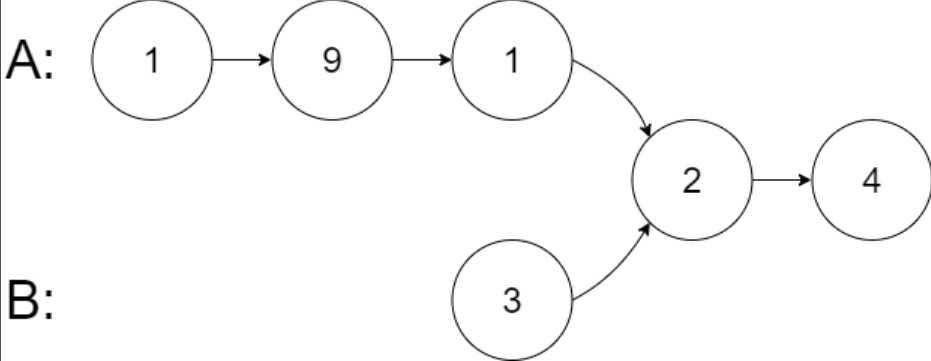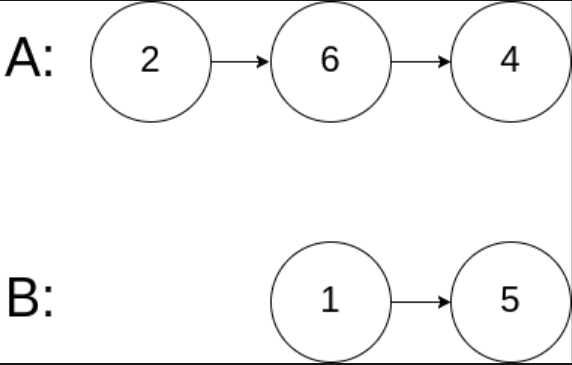一、题目描述
给你两个单链表的头节点headA和headB,请你找出并返回两个单链表相交的起始节点。如果两个链表不存在相交节点,返回null。
图示两个链表在节点 c1 开始相交:
题目数据保证整个链式结构中不存在环。
注意,函数返回结果后,链表必须保持其原始结构。
自定义评测:评测系统的输入如下(你设计的程序不适用此输入):
intersectVal- 相交的起始节点的值。如果不存在相交节点,这一值为0listA- 第一个链表listB- 第二个链表skipA- 在listA中(从头节点开始)跳到交叉节点的节点数skipB- 在listB中(从头节点开始)跳到交叉节点的节点数
评测系统将根据这些输入创建链式数据结构,并将两个头节点headA和headB传递给你的程序。如果程序能够正确返回相交节点,那么你的解决方案将被视作正确答案。
示例 1
输入: intersectVal = 8, listA = [4,1,8,4,5], listB = [5,6,1,8,4,5], skipA = 2, skipB = 3
输出: Intersected at '8'
解释: 相交节点的值为8(注意,如果两个链表相交则不能为0)。从各自的表头开始算起,链表A为[4, 1, 8, 4, 5],链表B为[5, 6, 1, 8, 4, 5]。在A中,相交节点前有2个节点;在B中,相交节点前有3个节点。
— 请注意相交节点的值不为1,因为在链表A和链表B之中值为1的节点(A中第二个节点和B中第三个节点)是不同的节点。换句话说,它们在内存中指向两个不同的位置,而链表A和链表B中值为8的节点(A中第三个节点,B中第四个节点)在内存中指向相同的位置。
示例 2
输入: intersectVal = 2, listA = [1, 9, 1, 2, 4], listB = [3, 2, 4], skipA = 3, skipB = 1
输出: Intersected at '2'
解释: 相交节点的值为2(注意,如果两个链表相交则不能为0)。从各自的表头开始算起,链表A为[1, 9, 1, 2, 4],链表B为[3, 2, 4]。在A中,相交节点前有3个节点;在B中,相交节点前有1个节点。
示例 3
输入: intersectVal = 0, listA = [2, 6, 4], listB = [1, 5], skipA = 3, skipB = 2
输出: null
解释: 从各自的表头开始算起,链表A为[2, 6, 4],链表B为[1, 5]。由于这两个链表不相交,所以intersectVal必须为0,而skipA和skipB可以是任意值。这两个链表不相交,因此返回null。
提示
listA中节点数目为mlistB中节点数目为n1 <= m, n <= 3 * 10⁴1 <= Node.val <= 10⁵0 <= skipA <= m0 <= skipB <= n- 如果
listA和listB没有交点,intersectVal为0 - 如果
listA和listB有交点,intersectVal == listA[skipA] == listB[skipB]
进阶
你能否设计一个时间复杂度O(m + n)、仅用O(1)内存的解决方案?
相关主题
- 哈希表
- 链表
- 双指针
二、题解
type NLink = *mut ListNode;
pub struct ListNode {
pub val: i32,
pub next: NLink,
}
impl ListNode {
pub fn new(val: i32, next: NLink) -> NLink {
Box::into_raw(Box::new(ListNode { val, next }))
}
}public class ListNode {
int val;
ListNode next;
public ListNode() {}
public ListNode(int val) { this.val = val; }
public ListNode(int val, ListNode next) { this.val = val; this.next = next; }
}Approach 1: 哈希集合
pub fn get_intersection_node(head_a: NLink, head_b: NLink) -> NLink {
if head_a.is_null() || head_b.is_null() {
return null_mut();
}
let mut set = HashSet::new();
while !head_a.is_null() {
let temp = head_a;
set.insert(temp);
unsafe {
head_a = (*head_a).next;
}
}
while !head_b.is_null() {
let temp = head_b;
if set.contains(&temp) {
return temp;
}
unsafe {
head_b = (*head_b).next;
}
}
null_mut()
}public ListNode getIntersectionNode(ListNode headA, ListNode headB) {
if (headA == null || headB == null) {
return null;
}
HashSet<ListNode> set = new HashSet<>();
while (headA != null) {
ListNode temp = headA;
set.add(temp);
headA = headA.next;
}
while (headB != null) {
ListNode temp = headB;
if (set.contains(temp)) {
return temp;
}
headB = headB.next;
}
return null;
}Approach 2: 双指针
pub fn get_intersection_node(head_a: NLink, head_b: NLink) -> NLink {
if head_a.is_null() || head_b.is_null() {
return null_mut();
}
let mut ptr_a = head_a;
let mut ptr_b = head_b;
while ptr_a != ptr_b {
unsafe {
ptr_a = if ptr_a.is_null() {
head_b
} else {
(*ptr_a).next
};
ptr_b = if ptr_b.is_null() {
head_a
} else {
(*ptr_b).next
};
}
}
ptr_a
}public ListNode getIntersectionNode(ListNode headA, ListNode headB) {
if (headA == null || headB == null) {
return null;
}
ListNode ptrA = headA, ptrB = headB;
while (ptrA != ptrB) {
ptrA = ptrA == null ? headB : ptrA.next;
ptrB = ptrB == null ? headA : ptrB.next;
}
return ptrA;
}